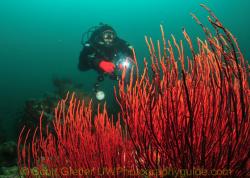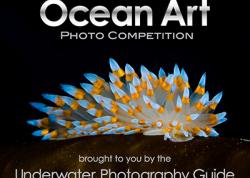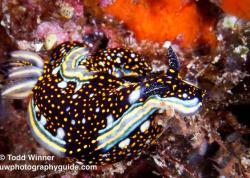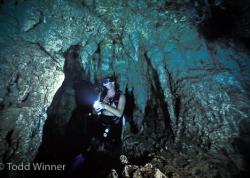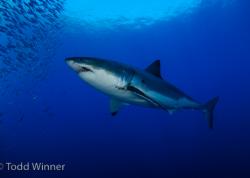Diving Papua New Guinea
Quick Links
Where to Stay | Dive Sites | Getting There | Underwater Photography
Papua New Guinea, also known just as PNG, puts the “exotic” into the word exotic. PNG is a tropical island sharing its western border with West Papua, Indonesia. There are parts of this country that are still unexplored by westerners. Topside and underwater, PNG offers incredible adventures. Getting there can be difficult and expensive.
Travelers have encountered poverty, disease, missed flights, and more – the capital has a bad reputation - but every traveler who returns raves about the experience and wouldn't hesitate to go back. The nation's extreme beauty along the rivers, at the seashore and in the Highlands is matched only by the magnificent coral reefs with their bountiful marine life. Enthusiastic birders, Scuba divers and other adventurous visitors find some of the world's best opportunities to enjoy their interests here.
There are very places in the world that can offer the combination of great diving and amazing cultural, trekking and birding experiences like PNG can.
PNG is very tropical – very green, lot of rain, humidity, insects, and critters out at night, etc. It is hot, wet and humid year round. It's also a malaria area.
If you are going to take the time and expense to visit PNG, it's probably should not just be for the diving (which is great), but also for the topside cultural experience, otherwise you will be missing out.

The “PNG” experience
One of the highlights of a PNG trip is the PNG experience. PNG has hundreds of different tribes, who all dress differently and speak different languages. Travel to most of areas of PNG will optional include a visit to the highlands, or a trip to the Sepik river, to visit some of these tribes.

Dancing children, photo by Randy Harwood

Map showing the best Papua New Guinea diving areas
PNG recommended dive Regions
Milne Bay
Original place for “muck diving”, with incredible macro diving. Lots of small critters. Ghost pipefish, seahorses, frogfish, cuttlefish, mandarin fish, lots of nudibranchs, etc. There are also reefs here with great hard corals and coral bommies packed with life. Night dives are great. Tufi resort and Tawali are here.
Walinidi / Kimbe Bay – new Britain island north coast
Lots of macro, seahorses, close to soft coral areas, vast hard coral expanses, great soft corals, amazingly dense hard corals with schools of jacks, millions of grunts, snappers, fuseliers. Lots of tropical fish, squid, cuttlefish, pygmy seahorses – good WA & Macro. Febrina liveaboard goes here. Best dove May – Nov. Kimbe bay area is quite colorful. Offshore to the northeast is Father’s reef, less colorful but with more currents and “big” stuff – sharks, barracuda, jacks, tuna. The Witu islands are offshore to the northwest. A trip on the Febrina often visits Kimbe Bay, Father's reef and Witu islands. Susan's reef is one of the best dives in this area.
Read our underwater photographer's guide to Kimbe Bay.


Soft coral at Kimbe Bay.
Kavieng – an area on the island of New Ireland
“Big animals” - reef sharks, big school of fish, lots of pelagic action, strong currents, big soft corals. Lots of currents. Great diving similar to Walindi / Kimbe bay area.

Schooling fusiliers, photo by Randy Harwood
Bootless Bay
Loloata island - a private island outside of Port Moresby
There's great diving here – great soft corals, good wrecks, great for rhinopias, great macro. The only downside is that you may not get the “full” PNG experience – the people – that you can get in the other locations. From Port Moresby, it's a short 1-hour drive to a boat dock, and then a 15 minute boat ride to the island – which is another draw.
Suzie's Bommie is a favorite dive site here, packed with life and excellent wide-angle and macro opportunities, including schooling fish, Napolean wrasse, reef sharks, jacks, lionfish, pygmy seahorses and Rhinopias. Here's a nice writeup on diving Suzie's Bommie. End Bommie is also a great critter site.
The Bootless Bay area is diveable year round, although visibility may be down from Jan to March. Mid October to mid-December brings the best conditions.
PNG Marine Life
Being in the middle of the golden triangle, PNG has incredible diversity of corals, fish, and macro subjects. There are big schools of jacks, cuttlefish, reef sharks and all of the other typical info-pacific reef life. You can see examples of the macro life on my underwater critter list. PNG consistently ranked as one of, if not the top place for seeing fish (big and small) and corals in the world.

Lacey Rhinopia, a great underwater photography subject. Photo by Randy Harwood

Leaf Scorpionfish. Photo by Todd Winner.
Chambered Nautilus
In the Kaveang area, they offer the chance to be in the water with a living chambered Nautilus. The nautilus are trapped in a baited trap at 800ft, and then brought up. The trap is opened, the nautilus come up, and you can photograph them as they start to descend back down to the depths.

Chambered Nautilus, photo by Randy Harwood
Papua New Guinea - Getting There
All divers enter PNG at Port Moresby. Flights usually connect from Singapore or Australia. For most destinations in PNG, you will then take additional flights. All travel in PNG is basically via airplane – planes in PNG are basically like buses. Flights have a unique atmosphere and passengers can be quite colorful. The total cost of flying to your destination in PNG can be quite expensive. Internal flights are often delayed or canceled.
Since you must fly into Port Moresby, you should visit PNG arts, a huge export shop for local, authentic PNG art. That said, Port Moresby does not offer the visitor any other attractions and should be avoided if possible. Don't go out after dark or by yourself.
Try to get a good baggage allowance when you book your flights, otherwise you might get continuously dinged as you travel through the country.
When to Go: Best time to visit PNG
You can visit PNG year-round. May to October can be a little drier, and it the best time for most places, but climates can vary around the country.
Visibility
Visibility can be quite variable, and there can be occasional plankton blooms. It's comparable to other info-pacific areas, usually 30-60ft.
Water temps
Fairly warm, usually 82-86 degrees
Where to Stay in PNG – Resorts and Liveaboards
For the best PNG dive resorts, visit the Papua New Guinea dive resort & liveaboard page on our sister website, Bluewater Travel
Topside Excursions
Visiting the highlands and Sepik river are often topside highlights of one's trip to PNG. If you visit the highlands, you want to visit to Wahgi valley mudmen and the Huli wigmen.
In the Sepik river area, the people live along the floodlands, and the people make incredible artifacts such as masks, food hooks, and wood carvings.


Elder Huli man, photo by Randy Harwood
Safety
PNG is a high-risk malaria area, be sure to take malaria pills, but even malaria pills do not always work. As in all international travel, but especially in PNG, you need to be aware of your surroundings, don't go places without a guide or a big strong person who can speak the local language. You don't want to walk around on your own. Some areas are very, very remote if you are trekking.
Underwater Photography Tips
Incredible macro and wide-angle, bring all of your lenses.
Papua New Guinea Underwater Photography

Silvertip Reef Shark, photo by Randy Harwood

Schooling Chromis

Sunken Bomber

Feeding Harlequin Shrimp

The gorgeous Kavieng Reef
Resources
The Marine Life of Bootless Bay
Further Reading
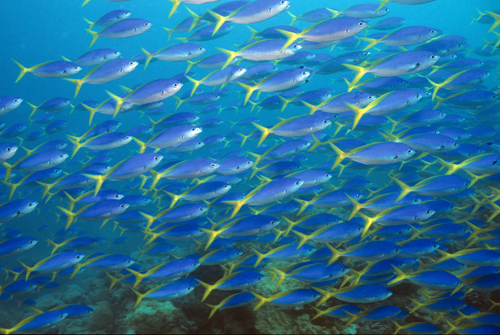
RECOMMENDED ARTICLES
SUPPORT THE UNDERWATER PHOTOGRAPHY GUIDE:
The Best Service & Prices on u/w Photo Gear
 Visit Bluewater Photo & Video for all your underwater photography and video gear. Click, or call the team at (310) 633-5052 for expert advice!
Visit Bluewater Photo & Video for all your underwater photography and video gear. Click, or call the team at (310) 633-5052 for expert advice!
The Best Pricing, Service & Expert Advice to Book your Dive Trips
 Bluewater Travel is your full-service scuba travel agency. Let our expert advisers plan and book your next dive vacation. Run by divers, for divers.
Bluewater Travel is your full-service scuba travel agency. Let our expert advisers plan and book your next dive vacation. Run by divers, for divers.




